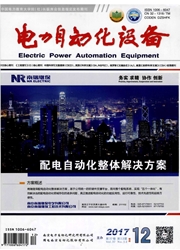

 中文摘要:
中文摘要:
电子式电流互感器在数字化与智能变电站中大规模应用,其特性与传统的电磁型电流互感器差异较大,需研究电磁型与电子式电流互感器传变和应涌流的特性。通过理论计算电磁型电流互感器暂态饱和后传变各次谐波的增益,证明和应涌流导致电磁型电流互感器饱和后,传变2次谐波的能力比传变基波的能力强,故2次谐波比反而升高;但分析表明经暂态饱和的电磁型电流互感器传变后和应涌流的间断角将减小。通过理论推导基于空心线圈的电子式电流互感器的传递函数,揭示了电子式电流互感器能否正确传变和应涌流主要取决于积分时间常数和衰减时间常数,和应涌流经电子式电流互感器传变后可能导致波形发生偏移,但其间断角特征和2次谐波含量不变,间断角和2次谐波制动判据不受影响。
 英文摘要:
英文摘要:
Since the electronic CT(Current Transformer) is now widely used in smart substations and its current transfer characteristics are quite different from those of traditional electromagnetic CT,it is necessary to compare the sympathetic inrush transfer characteristics between electronic and electromagnetic CTs. The transfer gain of transiently saturated electromagnetic CT is theoretically calculated for the harmonic of different orders,which shows that,after the electromagnetic CT is saturated by the sympathetic inrush,its transfer capability for the second-order harmonic is better than that for the fundamental,resulting in the increased second-order harmonic ratio and reduced dead-angle of the transferred sympathetic inrush. The transfer function of electronic CT based on air-core is theoretically deduced,which shows that,the proper sympathetic inrush transfer depends mainly on its integral time constant and decay time constant;the waveform of transferred sympathetic inrush is possibly shifted,but its dead-angle characteristics and secondorder harmonic ratio are unchanged,resulting in the uninfluenced dead-angle and second-order harmonic restraint criteria.
 同期刊论文项目
同期刊论文项目
 同项目期刊论文
同项目期刊论文
 期刊信息
期刊信息
